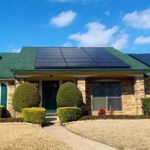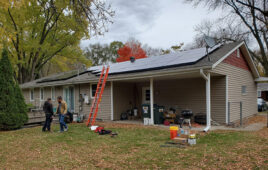347 organizations representing a true grassroots movement — spanning business to housing to environmental advocacy groups, issued a statement of support to protect rooftop solar in California.
The open letter signed by a diverse coalition of organizations, sent to Governor Newsom and the California Public Utilities Commission, demands state leaders keep solar affordable in California as the Newsom Administration considers changes to net energy metering (NEM), the state policy that defines how solar users send energy back to and interact with the electric grid.
View the coalition members below:
Solar is incredibly popular in California, in part because net metering is putting the benefits of rooftop solar in the hands of more people by making it more affordable. In fact, working and middle-class neighborhoods make up nearly 50% of today’s rooftop solar market.
“80% of Californians support net metering as it is today because it is proving successful and bringing solar to more homes, schools and small businesses,” said Dave Rosenfeld, executive director of the Solar Rights Alliance. “Net metering is helping bring costs down and making it possible for more people to access the savings, resilience and other benefits of solar power while also moving California closer to our clean energy goals. Voters of all backgrounds want to continue that progress. They know the utilities do not have their best interests in mind.”
Proposals submitted by the big utilities to gut net metering would drastically reduce the credit solar consumers receive for the excess energy they produce and add a $65-90 monthly solar penalty fee to their energy bills.
By holding back rooftop solar, which is more efficient, the utility profit grab would cost California tens of billions of dollars over time and each ratepayer $295 a year.
“While the big investor owned utilities have money and political influence, our power comes from our diverse coalition representing the needs and desires of environmentalists, conservationists, farmers, students, disabled communities, renters, churches, schools, labor, and small businesses across the state,” said Jessica Tovar, Energy Democracy Organizer with the Local Clean Energy Alliance. “Our grassroots coalition represents California voters from all walks of life, who overwhelmingly support the growth of local solar; like microgrids and oppose the push by investor-owned utilities to increase their own profits by making solar more expensive for everyone.”
By undermining net metering, making solar more expensive for everyone and halting critical clean energy expansion, the utility profit grab is out of step with California’s environmental and clean energy goals and the growing need for a reliable energy supply in the face of wildfires and grid outage events.
“California is in a climate emergency, with record shattering heat waves, drought and wildfires spreading across the state,” said Laura Deehan, State Director of Environment California. “With so much at stake, California gutting net metering would reverse our trajectory as a leader in solving global warming right when our leadership is needed most.”
The Save California Solar coalition is calling on the CA Public Utilities Commission to strengthen net metering in two ways by making it easier and more affordable for everyone, and increasing battery accessibility for those who go solar, thereby increasing the community benefits of rooftop solar.
News item from Save California Solar







I am not understanding the dynamics of undermining net metering? There is a great deal of rhetoric here on this website.
Compared to the following legislation signed into laws (Several Bills) -https://www.cpuc.ca.gov/industries-and-topics/electrical-energy/demand-side-management/net-energy-metering what is actually changing and what is being undermined?
A friend is telling me that PUC will be doing away with Net Energy metering and solar customers will be getting zero dollars back and will have to pay the utlities to send their energy over their grid apparatus system?
“347 organizations representing a true grassroots movement — spanning business to housing to environmental advocacy groups, issued a statement of support to protect rooftop solar in California.”
These groups might want to “copy” to Caitlyn Jenner, Larry Elder, John Cox and Kevin Faulconer just in case.
“Using a state-of-the art grid planning tool, the analysis goes beyond the limitations of traditional electricity system planning by leveraging big data and advanced analytics to produce a more complete and inclusive picture of the direct costs and benefits of all resources on the grid.”
That $295 a year savings to ratepayers is biased towards utilities and doesn’t dive deep enough into the savings a home owner can gain from a large solar PV array on the roof and a smart ESS in the garage. Over the years of solar PV use, I have been able to “consistently” pay for my homeowner’s insurance for a (year) with savings on electricity over the year. Buy an EV and charge at home, one could add that energy expense back to the household budget and pay for some of one’s groceries over the year in energy savings alone.
“By undermining net metering, making solar more expensive for everyone and halting critical clean energy expansion, the utility profit grab is out of step with California’s environmental and clean energy goals and the growing need for a reliable energy supply in the face of wildfires and grid outage events.”
The technology available today makes it much more likely that folks who have actually “studied” solar PV and energy storage have found they can adopt this technology for themselves and actually save a few thousand dollars per year in energy costs. While all of this “dissent” is being ‘articulated’, folks are leaving money in the bank at a lousy 0.5% to 1.5% APY, when they could put that money on the roof of their homes in solar PV and in their garages as smart ESS and home EV charger and save on energy costs both electricity and gasoline and pay for their system in around 5 years. That money can go towards the “other” household budget costs over the year. At this point, there is still the Federal ITC to help with the upfront costs of this system. the statement above focuses on “making solar” more expensive for ‘everyone’, does not do justice to the differential of retail electricity costs and wholesale energy costs. Let’s face it many in Wyoming don’t see all the “to do” about solar PV as they still have plenty of $0.08/kWh electricity available to them. California on the other hand the (average) cost for electricity is from $0.20/kWh to $0.25/kWh and in Southern California monthly electric bills are ridiculous during four months of the year.